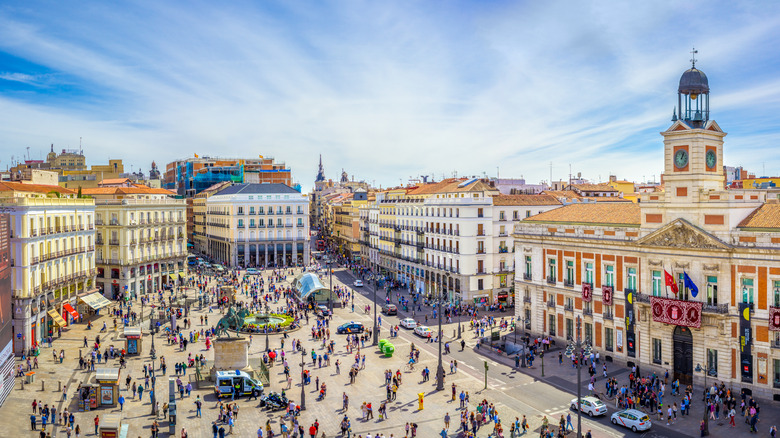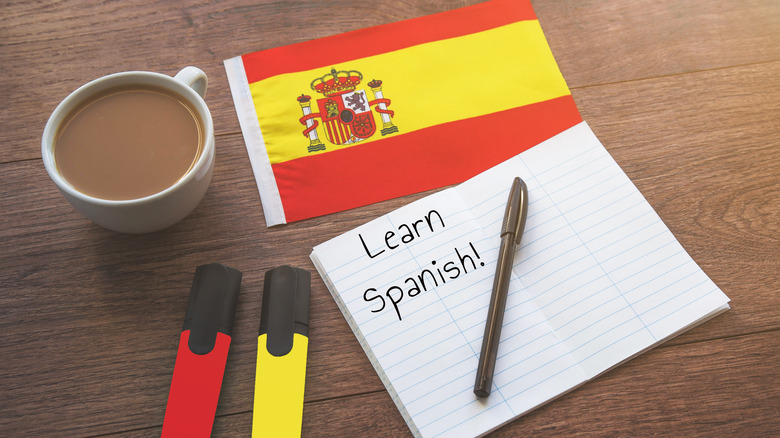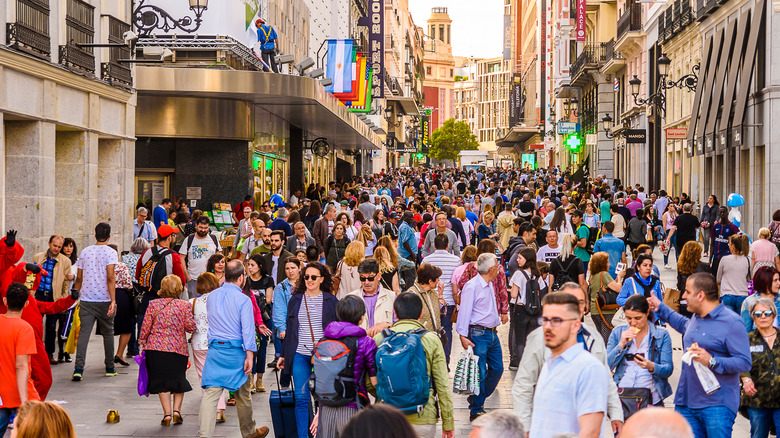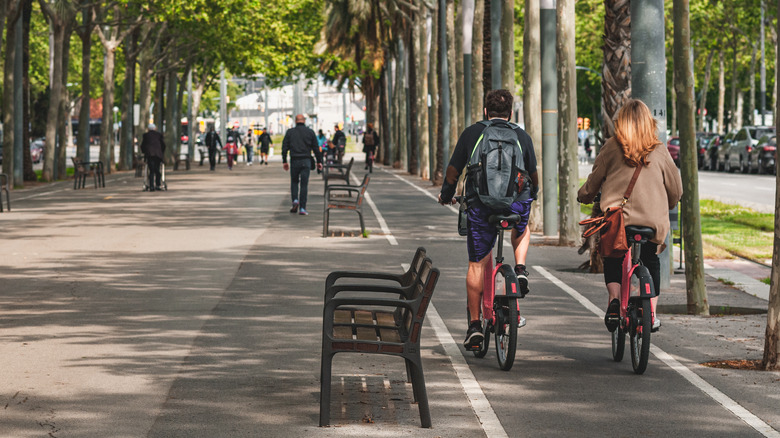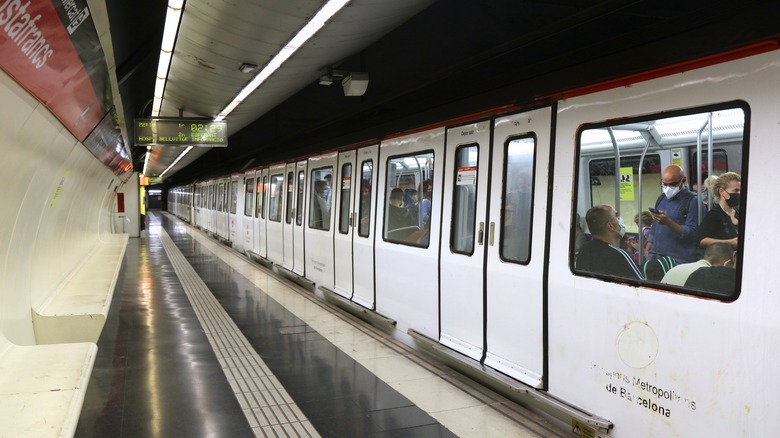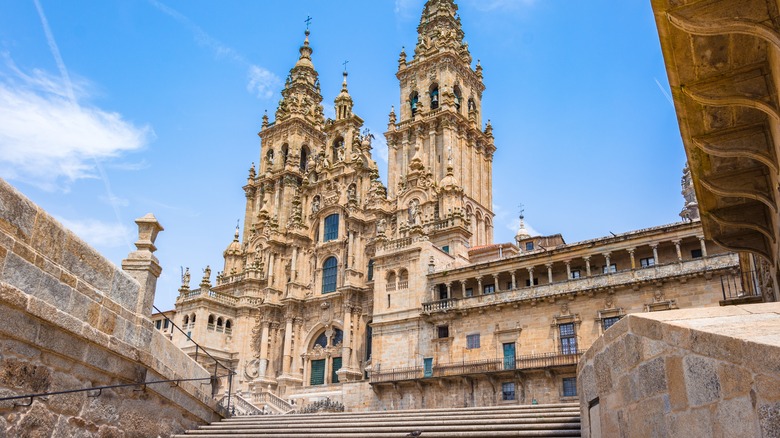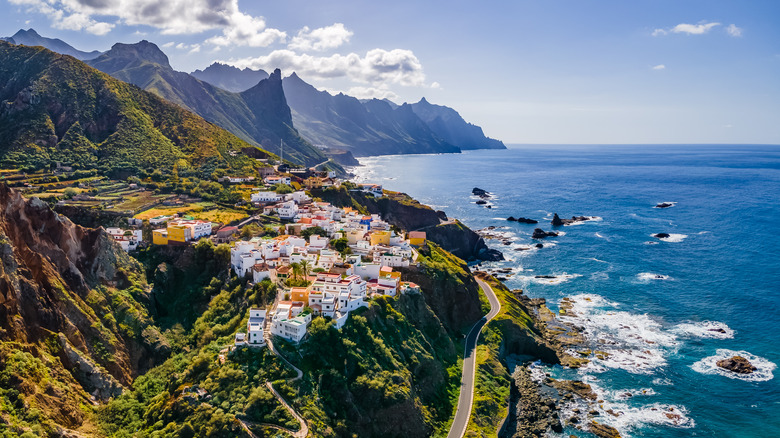Essential Words And Phrases To Know Before Your Trip To Spain
While a lot of influences have shaped the language that we know today as Spanish, none had a greater input than Latin, with some theories that it was the Latin spoken by Roman soldiers, not academics or scholars, that was its true origin. As time passed, the Visigoths and Moors, also active on the Iberian Peninsula, stamped their imprint onto the language, and slowly it evolved. Eventually, Castillian Spanish was codified and officially born, a language that could easily have stayed contained in a part of Southern Europe. But Spanish colonization from the 15th century took the country's culture and linguistics around the globe.
Today, after English, this European language has perhaps the furthest reach around the planet, the national language of many nations in Central and South America. Spanish is a useful language to be familiar with, not just for travels to Spain and elsewhere, but also here in the United States, with some studies predicting that the country will have the largest Spanish-speaking population in the world by 2050. And while you can use apps like Google Translate or a phrase book to do the work for you, there's something personal about rattling off a sentence without using a phone or consulting pages. It will also help you feel more like a local, and isn't that the joy of travel?
The mechanics
Unlike English, Spanish is phonetic, meaning it reads as it is written. Some letters are pronounced differently from English. A 'j' has more of an 'h' sound, as does a 'g' when preceding an 'e' or 'i'. The letter 'c' can sound like a 'k' or 's' depending on what follows after it, and two 'l's together (i.e. 'll') will sound like a 'y'. The letters 'b' and 'v' sound extremely similar (imagine a cross between the two), while the 'x' is more aligned to 'ks' than its English sound, and 'z' sounds like 'th.' Many newbies struggle with the 'ñ', which sounds like 'ny'.
Spanish has a couple of universal guidelines that will help you place the correct stress on a word. If a word ends in a vowel or the consonants 'n' or 's', then the stress should be on the penultimate syllable — for 'manzana,' which means apple, place slightly more emphasis on the -za part. For Spanish words that end in a consonant that is not an 'n' or 's', the stress falls on the last syllable — 'reloj', meaning clock, should be spoken with the emphasis on the -loj. If you see the acute accent over a letter, ignore those rules and simply emphasize the syllable with the accent. Got it?
Counting
The building blocks of any language, numbers, or 'numéros,' are straightforward and follow a loose pattern, though you will have to learn them rote. One to 10 is 'uno,' 'dos,' 'tres,' 'cuatro,' 'cinco,' 'seis,' 'siete,' 'ocho,' 'nueve,' and 'diez.' From 11-19, the words vaguely resemble the 1-10s, but transform format after 15 — 'once,' 'doce,' 'trece,' 'catorce,' 'quince,' 'dieciséis,' 'diecisiete,' 'dieciocho,' and 'diecinueve.'
For numbers 20-99, the easiest way is to remember the multiples of 10 'veinte' (20), 'treinta,' 'cuarenta,' 'cincuenta,' 'sesenta,' 'setenta,' 'ochenta,' and 'noventa' (90) as the foundations, then add the letter 'y' afterward (pronounced like the English 'ee') and then the relevant 1-9 number (though this isn't entirely accurate for numbers in the 20s, the sound is similar enough that this hack will work). So 53, for instance, is 'cincuenta y tres'.
The 100s develop from the root of 'cien', or 100, and increase by kind of adding the initial parts of the 2-9 terms, hence 'doscientos,' 'trescientos,' 'cuatrocientos,' 'quinientos,' (500), 'seiscientos,' 'setecientos,' 'ochocientos,' and 'novecientos.' To create a three-figure number, simply stitch together the component parts — hence 682 is 'seiscientos ochenta y dos.' Easy as 1-2-3.
Basic Spanish words
Just like in English, there are small words and simple phrases that you will hear frequently. Yes is 'si' (by now, you should know how to pronounce this, but if not, it's like the English see/sea), while no is, wait for it ... 'no,' though in the Spanish version, the 'o' is much shorter. The English OK is the same in Spanish, though you might hear people say 'vale' a lot (it will sound like they are saying 'ba-lay'), which also means OK; the phrase 'of course' is denoted by 'claro.'
To amplify your sentiments, add 'muy,' or very, before an adjective. And if you find you are struggling to be understood, try asking the person if they speak English, or '¿Habla Inglés?'. You'll notice that Spanish questions, when written, have two question marks, the first upside down. The reason for this is to assist readers in identifying that the phrase is a question, so they can use an intonation appropriate for a question.
Spanish greetings
Greetings are an important part of the day, a tried-and-trusted conduit to break the ice with family, friends, colleagues, even complete strangers. They are also critical components for being civil and cordial. More than just the name of a celebrity publication, 'hola' is how Spanish speakers say hello. Note that the 'h' is rarely pronounced in Spanish.
Good morning is 'buenos días,' while good afternoon is 'buenas tardes,' and in the evening, try 'buenas noches' (for the last two, the ending for the word for 'good' changes. This is because Spanish has masculine and feminine words, and adjectives change to agree with the word. 'Tarde' and 'noche' are feminine words, so the 'buenos' for 'días' becomes 'buenas' for 'tardes' and 'noches').
To ask someone about their well-being, say ¿Cómo está?', or 'how are you,' and their response, hopefully, will be 'bien,' or 'muy bien' (good, or very good). A more relaxed way to ask this is '¿Qué tal?', a bit like asking 'what's up?' If somebody wants to know your name, they might say '¿Cómo se llama?', and you can respond with 'Me llamo ...'.
Mind your Ps and Qs
Tourism isn't something that you should take for granted — it's a privilege to be able to explore and enjoy a different city, coast, country, and culture, and a blessing that destinations allow us all to share that (yes, we know, they like the monetary benefits too!). Nobody likes a rude tourist, so don't be one — the easiest way is to master a few stock phrases that will serve you time and time again. The two most important ones are please and thank you — 'por favor' and 'gracias' — both of which are phrases that you might already recognize.
If you want to say excuse me, either when you approach someone and want to be polite before asking a question, or if you want to get past someone in a crowded place, try 'disculpe' before the question, or 'con permiso' in physical situations. And, if you are lucky enough to be on the receiving end of thanks — well done, by the way — your options by way of reply are 'de nada' (it's nothing, or you're welcome), or 'es mi placer' (my pleasure).
Spanish phrases for eating out
Chances are you'll be eating out on your travels, whether at a roadside food cart, cute cafe, or fancy restaurant. For these times, a few specific terms are key. 'Cuantos personas' signifies a server or host enquiring how many people are in your group. You'll be shown to your 'mesa', or table, and if you prefer one by the window, you should ask for 'una mesa junto a la ventana'.
Of course, you will need to ask for 'el ménu' to see what dishes are on offer, and when you are ready to order, you can tell the waiter 'estamos listos', or 'we are ready' ('estoy listo' for one person). You can point to what you want, but for more panache, start with 'quisiera' or 'I would like...,' followed by the name of the dish. If you wonder about the size of the item, ask '¿Es una gran porción?', which sounds pretty similar in English. The Spanish words for vegetarian and vegan are also like their English counterparts — 'vegetariano' and 'vegano' (or 'vegetariana' and 'vegana' if using the feminine). When it's time to pay, ask for 'la cuenta,' also known as 'la factura' in some Spanish-speaking countries.
Drinking it in
Meals, though, aren't meals without having a little tipple, and you'll need to learn how to order a drink whether you are in a restaurant, an upscale bar, or a typical Spanish 'taberna'. The word for drink is 'bebida', but that is just an umbrella term, with specific words for individual libations. You might hear a waiter or barkeep ask '¿Algo para tomar?", '¿Qué quieres tomar?', or '¿Algo de beber?', all essentially asking if dyou want something to drink. Respond with the appropriate tipple, 'agua' for water ('con gas' if you want sparkling), 'vino' for wine (either 'blanco' or 'tinto', white or red), 'bebida gaseosa' or 'refresco' for a soda, or 'cerveza' for beer.
Other useful terms describe units of measurement for your drinks — 'uno vaso' (a glass), 'una botella' (bottle), and 'una jarra' (a pitcher). And if you like your tipple cold, make sure to add 'con hielo,' for 'with ice,' and maybe 'una pajita,' for a drinking straw.
Getting out and about
It's all good and well to use these terms in static situations, when you have a moment or two to gather your thoughts, but what about when you are exploring the city and need to think on the fly? How can you get helping locating attractions, or even a restroom when nature calls? You start with '¿Por favor, quisiera ayuda?', to say 'please, I would like some help,' or '¿Disculpe, dónde está . . . ?', meaning 'excuse me, where is ... ?' You can also try 'Estoy buscando', meaning 'I am looking for.'
For institutions of art and creativity, you'll need to find 'el museo', or the museum, and for libraries, you will ask for 'la biblioteca'. Directions will probably send you 'a la derecha' (to the right), 'a la izquierda' (to the left), or 'todo derecho' (straight ahead), and you might need to navigate 'la calle' (the street), 'la avenida' (the avenue), or 'el callejón' (the alley), to get there. If you really need to go — you know, go — ask for 'un baño,' and couple it with the adjective 'cerca' (or close by).
Scouring the supermarket
Even if you like to eat out on vacation, you might find yourself going into a supermarket, or deli, or bodega (there's a Spanish word you already know!) to pick up something to sip or snack on while you wander around. You might also like to cook your meals at the place where you are staying, like a rental apartment, in which case you will definitely need to get to source some supplies. A shop in Spanish is 'tienda', but specialized shops have different names — examples include 'panadería' (bakery), 'carnicería' (butcher's shop), and 'supermercado' (supermarket). The last is probably the most important for self-catering vacationers, with sections dedicated to 'carnes' (meats), 'lácteos' (dairy), and 'frutas y verduras' (fruits and vegetables).
You might also need medicine from a 'farmacia'. While it would be impractical to list all the items a traveler might purchase, a few essentials are 'leche' (milk), 'huevos' (eggs), and 'pan' (bread). At check out, if you want to pay by credit card, ask '¿Aceptan tarjetas de crédito?' (most likely, the store does), though when paying by cash, be sure to check the 'cambio,' or change.
Shopping supreme
Buying daily essentials in a supermarket is unlikely to be the only shopping that you will be doing. No doubt, you'll feel the proverbial wind in your sails, the sun on your back, and you'll hit the stores with bit more extravagance in mind, perhaps for some purchases to take back home. Think souvenirs, clothes, unique items that will remind you of your trip. You can use some of the information you learned in the slide above, but prepare to take it up a notch.
When you want to try on an item of clothing, ask '¿Me la puedo probar?' If the fit is all wrong, go with '¿Tienes está in otra talla/otro tamaño?' with 'más pequeña' for smaller, and 'más grande' for bigger. You might also want to check the price, in which case ask '¿Cuánto cuesta?' And if you want to bargain, boldly lead with '¿Me puede dar un descuento?' (can you give me a discount?). Don't ask, don't get.
Cinematic style
We are so used to seeing movies in English, that we forget that people round the world see them in other languages. Watching a film while on vacation is fun, and it's also a novel thing to do, not the typical travel excursion that most of us think about. While you can see a film in a foreign language, you might also be able to see one in English with Spanish subtitles (especially if it's a blockbuster), but you will still have to navigate the movie hall.
The place where you see 'la película' is 'el cine', and you will watch it from 'el asiento' (the seat). Of course, you will need to buy 'un boleto/billete' (a ticket) to watch the screening, and maybe even a drink (you know that already!) and 'palomitas' (popcorn). After that, you'll be able to breeze through to your seat by saying excuse me and thank you.
Transport yourself away
A key component of any trip, the logistical part of getting from one place to another on vacation is often laden with anxiety. But a few simple terms can help to put your mind at rest. Most likely you will arrive at 'el aeropuerto', and after passing through 'immigración y aduanas' (immigration and customs), you'll look for a 'taxi', 'tren', or 'metro' into the city center. At some point, visitors will need to find the nearest station, and the Spanish word for this, both for trains and metro, is 'estación.' Buses are convenient ways to get round a city, and you catch them from 'una parada', or a stop. You can locate any of these by combining the relevant word with the '¿donde está?' construction highlighted earlier.
Tickets are one-way or round-trip, or 'billete de ida' and 'billete de ida y vuelta.' On the trip returning to your home country, you'll need to make sure you get to the correct 'terminal' and find the 'puerta' (gate, and it also means door) for your flight. An important word you'll need when scouring transport is 'próximo/próxima', which means 'next,' and you can use it for asking about the next train, metro, or stop. And if you need advice on the route to take, try '¿Qué autobús/metro va a [insert destination]?'
A landmark to remember
You'll need to be able to identify specific buildings, from museums to airports to libraries, and while some of these have already been discussed, there are plenty more to learn. A vacation is rarely cheap, and during it, travelers are likely to need to withdraw money from a 'banco,' where they will look for an ATM machine, or 'cajero automático.' On a sunny day, outdoors enthusiasts might want to stop by a 'parque' or 'jardín' (garden) for some downtime, or a picnic, or stroll around to see an exhibition at a 'galería de arte.'
Fine architecture often presents itself at religious institutions like a 'catedral' or 'iglesia' (the first is similar to its English equivalent, and the second means church). Cities are often prized for their 'monumentos' (monuments), and ornate buildings like 'palacios' (palaces) and 'monasterios' (monasteries). If one place can help you learn more about the city, it would be the 'centro de información turistica' (tourist information center). And when the day winds down, and you need to rest, you'll probably want to get back to your 'hotel' or 'casa' (home).
The call of nature
Hopefully, wherever you go, you'll experience some of your destination's natural wonders. These could be the parks and gardens, places mentioned earlier, or even the beaches, or 'playas,' strands of sand that grace the shores of many cities in Spanish-speaking countries. Further afield, in the greater wilderness, you might encounter 'las montañas' (the mountains) and 'lagos,' or lakes. In Spanish, the word for countryside is 'campo,' part of what locals might call 'la naturaleza', or nature, places where might find a 'bosque' (forest), a 'granja' (farm), or a 'selva' (jungle).
The reach of nature also extends to waterways, like 'el rio' (the river), 'el mar' (the sea), and 'el cascada' (the waterfall). If you want to experience the outdoors, you can say 'me gustaria ver/explorar/visitar la naturaleza' (I would like to see/explore/visit nature), or specify which particular type of natural attraction you want to enjoy.
Spanish words to use if in distress
We are leaving this section to the last, in the hope that you won't need to call upon it. Unfortunately, emergencies occur when you least expect them — you might get injured, not know where you are, or have your possessions stolen — and it's handy to learn a few key phrases that you can use in your time of need. By now, you will have learned how to ask someone for help, but if you are lost, use 'estoy perdido.' If it's one of your children that can't be found, 'mi hijo está perdido' (or 'hija está perdida' for a female child) is how to relay that your son or daughter is missing.
If a theft has occurred, notify the police ('policía') and tell them 'quiero reportar un robo' (you want to report a robbery). If the issue is with your health, and you require the assistance of a doctor, try 'necesito un médico' to say that you want to see a doctor. Hopefully, you'll never use any of these phrases, but as the saying goes, better safe than sorry.
